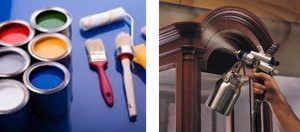Painting
Today there are many types of dyes to colour wood: chemical concentrates which can be dissolved in water or in alcohol, water stains that are derived from the walnut husk and from the extract of mahogany, alcohol based dyes which can be used for colouring shellac.
For restoration of course, it is not appropriate to use modern chemical dyes (which on the other hand are ideal for furniture in the “modern style”), the restorers who want to follow a more orthodox practices have to use traditional colours, such as water or alcohol based mordants.
[bullet_list icon=”play” indent=”10px” style=””]
- Water based Mordants: they have granules that dissolve in warm water. The intensity of colour is given by the amount of dissolved product used. It is best to start with small amounts and do trials on pieces of wood until the desired shade is obtained. The most commonly used mordants are walnut, mahogany, cherry and rosewood, which once dissolved can be mixed to obtain various shades, for example a little ‘mahogany can be added to walnut to give it a shade of red which makes the colour warmer. Conversely a little walnut can be added to mahogany to darken it.
Keep in mind that the mordant changes colour when dry, but recovers its tone in the finishing phase (shellac, wax or varnish). It is applied using a brush or preferably a soft sponge. Before the stain soaks into the wood to dries or you pass a rag to remove excess and uniform colour, this especially on porous wood (fir, pine, chestnut etc).
It is important, before applying the dye, the wood should be dampened with water using a cloth, when dry, it is lightly sanded with medium grit sandpaper (220), this will reduce swelling of the fibres, typical of water-based paints.
To create a more uniform appearance with fewer lighter or darker spots some restorers apply a layer of shellac and then sand it lightly (220) before applying the mordant.
With this type of dye you can use water based clear finish or a synthetic one.
- Alcohol based mordants: they usually come in powder form and are dissolved in alcohol 90°. Also in this case the colour intensity is given by the quantity of the product dissolved. These dyes are recommended for colouring small pieces or to make touch ups since, being alcohol, they dry rapidly which makes controlling the colour difficult. They are applied with a brush along the grain as quickly as possible and immediately after, a rag is used to remove the excesses and make the colour uniform.
Alcohol based mordants can be mixed together to obtain the desired colour and can be used to colour shellac.
[/bullet_list]


